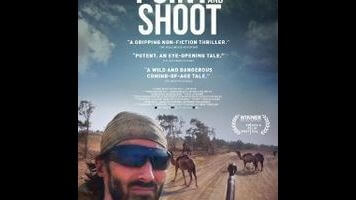What if Grizzly Man had ended differently? What if Timothy Treadwell—who was ultimately killed by the same bears that he loved and pledged his life to protect—had survived the attack, or avoided it altogether? It’s a moot point in the end, as Treadwell’s fate is clearly part of what compelled Werner Herzog to tell his story. Watching Marshall Curry’s Point And Shoot, however, it becomes tempting to consider how differently Treadwell might have been depicted and perceived his circumstances if his luck hadn’t run out.
As with Herzog’s film, Point And Shoot is the portrait of a lanky, restless, and potentially disturbed member of the middle class as told through his own amateur video. Curry’s Timothy Treadwell is a sheltered 29-year-old named Matthew VanDyke, and his death wish takes the form of the Libyan Revolution. A shy and sheltered kid who grew up on a steady diet of Alby Mangels nature films and dreamed of having an adventure on par with that of T.E. Lawrence, VanDyke matured into an ordinary guy who found himself tortured by the same ideals of manhood that inspired him as a child.
One day in 2011, VanDyke sees a news report about the tension in Tripoli, and something snaps. Struggling to recover from his girlfriend’s accusation that he’s a coward, VanDyke decides the struggle to overthrow Gaddafi’s dictatorship is the perfect opportunity to give himself a “crash course in manhood,” and so he buys a one-way ticket for Libya, flying across the world with little more than a motorcycle, a camera, and some wide-eyed white-boy wonder.
For reasons that become clear as the film moves along, VanDyke’s story didn’t come to Curry’s attention until after he had safely returned home. Point And Shoot is framed by a series of conversations between the two men in VanDyke’s Baltimore living room, as the reborn thrill-seeker reviews the footage from his travels. That footage comprises the brunt of Curry’s film, with the Academy Award-nominated director of Street Fight and If A Tree Falls: A Story Of The Earth Liberation Front weaving highlights from VanDyke’s increasingly troublesome travelogue, home video of his subject as a kid, and the interview being conducted between them in the present.
VanDyke’s story is compelling in and of itself, and initially it seems as though Curry were brought into the mix as little more than a glorified editor. As Point And Shoot enters its second half, however, VanDyke’s footage finds him blurring the line between fearless tourist and reckless revolutionary, at which point Curry’s mediating presence becomes a necessary invitation to question the integrity of VanDyke’s actions.
Curry’s target audience is that broad swath of American filmgoers who would never dream of uprooting their lives to venture into any of the foreign instabilities that dominate their dinnertime conversations. Point And Shoot is dependent on tickling their awe and admiration with VanDyke’s gung-ho odyssey. The film does everything in its power to codify VanDyke as a paragon of self-discovery in a world where the limits of a person’s identity have become as inflexible as the borders of their country; the wall-to-wall soundtrack of songs by The National (with whom Curry collaborated on the doc Mistaken For Strangers) is enough to instill a liberal respect for VanDyke’s YOLO spirit. Moreover, VanDyke’s transparent inquiry into the logistics of documentary filmmaking (he talks at length about how he has to stage all of the footage of him riding his motorcycle) suggest a self-awareness that should protect him from his worst impulses.
But the more straightforward Point And Shoot seems, the more slippery it becomes. The first red flag is raised when VanDyke reaches Afghanistan, and records himself declaring that he’s changing his name to “Max Hunter.” Later, after befriending a kind Libyan hippie, VanDyke is arrested and detained in terrible conditions for six months. When VanDyke refuses to return to the U.S. after his release, Curry’s ostensibly rose-colored regard for his subject assumes a different complexion. As VanDyke steps deeper into the Libyan Revolution, he begins to seem less like an overzealous innocent and more like a dangerously naive and narcissistic sociopath. As the situation intensifies and VanDyke begins to look the part of a freedom fighter, he retreats into facile debates about the ethics of documentary filmmaking in order to shield himself from more pressing questions about how he’s using the uprising as a shell game for his own self-discovery. “Is this authentic?” VanDyke asks himself in the middle of a firefight, moments before remembering that he left his gun in the car. A world away, his girlfriend and his parents wait for any word that he’s alive, but they couldn’t be further from VanDyke’s mind.
VanDyke refers to the Libyan conflict as “the most filmed war in history,” yet that claim doesn’t cheapen his footage, the extraordinary access of which is marred only by its shooter’s limited perspective. He returns home with extremely valuable images, and—among other things—Point And Shoot is a capable mechanism of sharing them with the world.
All told, however, what viewers ultimately think of VanDyke is less interesting than what they think about what Curry thinks of VanDyke. As its final moments make clear, this is the rare film in which what the filmmaker thinks of his characters isn’t just a question worth asking, it’s also a question that the text asks itself. If only the answer weren’t so obvious.

